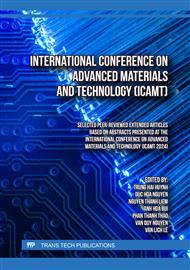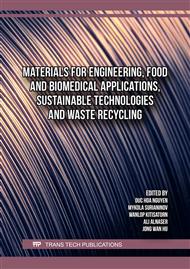p.3
p.11
p.17
p.27
p.33
p.43
p.49
p.61
Reduction of the Residue from the Leaching Process of Electric Arc Furnace Dust
Abstract:
Since electric arc furnace dust (EAFD) contains a certain amount of zinc (Zn), recovery of this metal is important. Many methods have been applied to recover Zn from EAFD so far. Pyro- and hydrometallurgical methods are recommended for this purpose. EAFD was leached using an ammonia carbonate solution, but the leached residue still had an amount of Zn that needed to be recovered. In the present study, the residue was mixed with coke, compressed into pellets, and heated at 1000 - 1200 °C for 30 - 90 minutes to investigate the reducing ability of the Zn compound. The residue was characterized by wet chemical analysis and the XRD method. The Zn content of heated pellets was analyzed to calculate the Zn removal efficiency. The obtained results showed that higher temperatures provided a strongly reducing reaction, the Zn removal efficiency was higher than 90 % for the pellet heated at 1100 °C for 60 minutes. It was concluded that combining the leaching method and carbothermic reduction could recover all amounts of Zn in the EAFD.
Info:
Periodical:
Pages:
17-23
Citation:
Online since:
December 2024
Authors:
Keywords:
Price:
Сopyright:
© 2024 Trans Tech Publications Ltd. All Rights Reserved
Share:
Citation:



